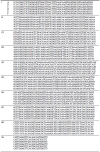Polymorphism of flagellin A gene in Helicobacter pylori
- PMID: 11854901
- PMCID: PMC4695594
- DOI: 10.3748/wjg.v7.i6.783
Polymorphism of flagellin A gene in Helicobacter pylori
Abstract
Aim: To study the polymorphism of flagellin A genotype and its significance in Helicobacter pylori (H. pylori).
Methods: As the template, genome DNA was purified from six clinical isolates of H. pylori from outpatients, and the corresponding flagellin A fragments were amplified by polymerase chain reaction. All these products were sequenced. These sequences were compared with each other, and analyzed by software of FASTA program.
Results: Specific PCR products were amplified from all of these H. pylori isolates and no length divergence was found among them. Compared with each other, the highest ungapped identity is 99.10%, while the lowest is 94.65%. Using FASTA program, the alignments between query and library sequences derived from different H. pylori strains were higher than 90%.
Conclusion: The nucleotide sequence of flagellin A in H. pylori is highly conservative with incident divergence. This information may be useful for gene diagnosis and further study on flagellar antigen phenotype.
Figures
Similar articles
-
Cloning and genetic characterization of the Helicobacter pylori and Helicobacter mustelae flaB flagellin genes and construction of H. pylori flaA- and flaB-negative mutants by electroporation-mediated allelic exchange.J Bacteriol. 1993 Jun;175(11):3278-88. doi: 10.1128/jb.175.11.3278-3288.1993. J Bacteriol. 1993. PMID: 8501031 Free PMC article.
-
Cloning and genetic characterization of a Helicobacter pylori flagellin gene.Mol Microbiol. 1992 Oct;6(19):2863-74. doi: 10.1111/j.1365-2958.1992.tb01466.x. Mol Microbiol. 1992. PMID: 1435261
-
Construction of expression systems for flaA and flaB genes of Helicobacter pylori and determination of immunoreactivity and antigenicity of recombinant proteins.World J Gastroenterol. 2003 Oct;9(10):2240-50. doi: 10.3748/wjg.v9.i10.2240. World J Gastroenterol. 2003. PMID: 14562386 Free PMC article.
-
Relationship between genotype and phenotype of flagellin C in Salmonella.World J Gastroenterol. 2001 Dec;7(6):864-7. doi: 10.3748/wjg.v7.i6.864. World J Gastroenterol. 2001. PMID: 11854918 Free PMC article.
-
Allelic variation in the Helicobacter pylori flagellin genes flaA and flaB: its consequences for strain typing schemes and population structure.Epidemiol Infect. 1995 Apr;114(2):257-66. doi: 10.1017/s0950268800057927. Epidemiol Infect. 1995. PMID: 7705489 Free PMC article.
Cited by
-
Identification of H. pylori strain specific DNA sequences between two clinical isolates from NUD and gastric ulcer by SSH.World J Gastroenterol. 2003 Aug;9(8):1747-51. doi: 10.3748/wjg.v9.i8.1747. World J Gastroenterol. 2003. PMID: 12918113 Free PMC article.
-
Sequence polymorphism in the glycosylation island and flagellins of Pseudomonas aeruginosa.J Bacteriol. 2004 Apr;186(7):2115-22. doi: 10.1128/JB.186.7.2115-2122.2004. J Bacteriol. 2004. PMID: 15028697 Free PMC article.
References
-
- Kamiya S, Yamaguchi H, Osaki T, Taguchi H. A virulence factor of Helicobacter pylori: role of heat shock protein in mucosal inflammation after H. pylori infection. J Clin Gastroenterol. 1998;27 Suppl 1:S35–S39. - PubMed
-
- Domingo D, Alarcón T, Sanz JC, Villar H, Hernández JM, Sánchez J, López-Brea M. [The Helicobacter pylori adhesion gene: relation with the origin of the isolates and associated disease] Enferm Infecc Microbiol Clin. 1999;17:342–346. - PubMed
-
- Monteiro MA, Chan KH, Rasko DA, Taylor DE, Zheng PY, Appelmelk BJ, Wirth HP, Yang M, Blaser MJ, Hynes SO, et al. Simultaneous expression of type 1 and type 2 Lewis blood group antigens by Helicobacter pylori lipopolysaccharides. Molecular mimicry between H. pylori lipopolysaccharides and human gastric epithelial cell surface glycoforms. J Biol Chem. 1998;273:11533–11543. - PubMed
-
- Yamaguchi H, Osaki T, Taguchi H, Hanawa T, Yamamoto T, Fukuda M, Kawakami H, Hirano H, Kamiya S. Growth inhibition of Helicobacter pylori by monoclonal antibody to heat-shock protein 60. Microbiol Immunol. 1997;41:909–916. - PubMed
MeSH terms
Substances
Associated data
- Actions
LinkOut - more resources
Full Text Sources
Research Materials


